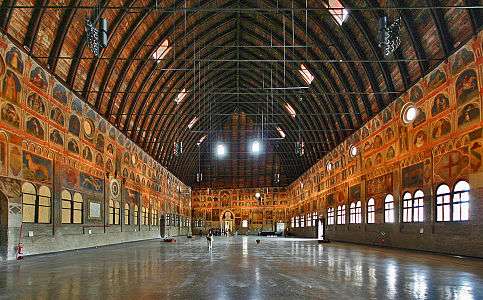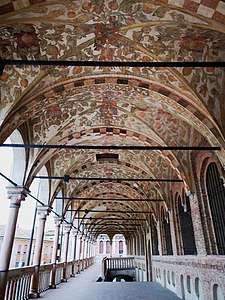Palazzo della Ragione, Padua
The Palazzo della Ragione is a medieval market hall, town hall and palace of justice building in Padua, in the Veneto region of Italy. The upper floor was dedicated to the town and justice administration; while the ground floor still hosts the historical cover market of the city. The palace separates the two market squares of Piazza delle Erbe from Piazza dei Frutti. It is popularly called "il Salone" (the big Hall).
.jpg)
Details
The building, with its great hall on the upper floor hence the name "Salone" ("big Hall"), is believed to be one of the largest medieval halls still extant; the hall is nearly rectangular, its length 81.5m, its breadth 27m, and its height 24 m; the walls are covered with allegorical frescoes. The building stands on arches, and the upper storey is surrounded by an open loggia, not unlike that which surrounds the Basilica Palladiana in Vicenza, that was indeed inspired by Padua's Palazzo della Ragione.
The Palazzo was begun in 1172 and finished in 1219. In 1306, Fra Giovanni, an Augustinian friar, covered the whole with one roof; originally there were three roofs, spanning the three chambers into which the hall was at first divided; the internal partition walls remained until the fire of 1420, when the Venetian architects who undertook the restoration removed them, throwing all three spaces into one and forming the present great hall, the Salone. The new space was refrescoed by Nicolò Miretto and Stefano da Ferrara, working from 1425 to 1440. Some of the frescoes depict the astrological theories of Pietro d'Abano, a professor at Padua University in the 13th century. The gigantic wooden horse on the western side of the hall was built in 1466 and is modelled on Donatello's Equestrian statue of Gattamelata which is in place on Piazza del Santo. On the eastern side there is a contemporary version of a Foucault pendulum.[1]
The ground floor hosts, since 800 years and likely the oldest in the European Union[2], the market hall of the city. Originally dedicated to the commerce of a wide selection of food, clothes, spices and jewels; it is today mostly active in the food and beverage sector.
A tornado destroyed the roof and damaged the building on 17 August 1756.[3]
 Great Hall of the Palazzo della Ragione
Great Hall of the Palazzo della Ragione- Great Hall with frescoes illuminated
 Portico
Portico
References
| Wikimedia Commons has media related to Palazzo della Ragione (Padua). |